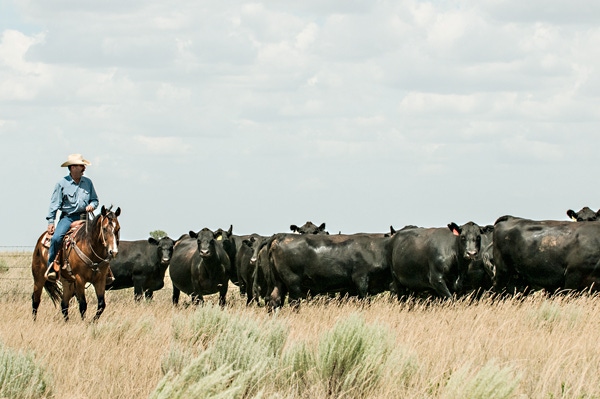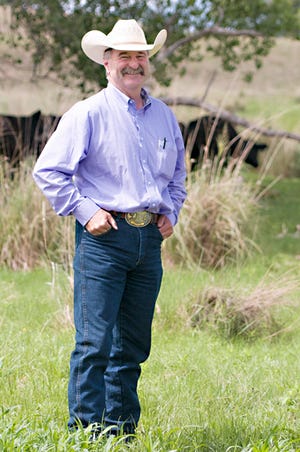Top carcass-value calves are just a generation away.
December 2, 2014

“A lot of people spend so much time and effort on things that don’t have anything to do with making money in the cattle business,” says Mark Gardiner of Gardiner Angus Ranch (GAR) at Ashland, KS. “It’s not too complicated. It involves calves that are born alive, grow efficiently, sell at a good pay weight when sold ahead of the feedlot or as a premium carcass through retained ownership, and leave a sister in the herd that will replicate it all again.”
Moreover, Gardiner says accomplishing this goal with genetics is just as straightforward.
“The old technology of using proven, high-accuracy bulls through artificial insemination [AI] works exceedingly well,” Gardiner says. His family is a longtime proponent of embracing technology and stacking proven genetics in the name of accelerated genetic progress.
Likewise, Tom Brink, founder of Top Dollar Angus (TDA) says, “I’ve never seen a time when we have more ability to control our future than we have in the industry today. A lot of what we’ve been wishing for the last 20 years is beginning to bear fruit.”
Brink is talking about the reliability of long-standing genetic selection tools and good old-fashioned reproduction technology. But, he’s also referring to the coming of age for genomic tools that yield direct economic benefit.
A recently completed study suggested by Brink and undertaken by GAR and Zoetis Genetics illustrates the point. Dubbed the Technology Two-Step (Tech 2) project, GAR and Brink purchased 104 single-source, run-of-the-mill, mixed-breed, yearling commercial heifers in spring 2012. Zoetis tested DNA from individual heifers and estimated their genetic merit for marbling as a Molecular Value Prediction (MVP).
Given the breed composition, the test used was designed for use in cattle of varying breeds. This isn’t to be confused with the high-percentage Angus Zoetis GeneMax suite of genomic tests that will be discussed later.
The heifer group had an average marbling MVP of -21.1, which is significantly below the Zoetis reference population for this test. GAR culled about a third of the heifers with the worst scores — an average of -55.1. The remaining 68 heifers had an average marbling score near zero, at -4.7. Nearly half of those had marbling genetics greater than the average of the reference population.

Mark Gardiner, Gardiner Angus Ranch at Ashland, KS
Next, GAR synchronized and AI-bred the keeper heifers to two Gardiner Angus sires that rank in the top 5% of the breed for calving ease and in the top 1% for the breed’s $B index, which recognizes growth rate and carcass value traits.
Calves resulting from these matings were born in spring 2013, and weaned and backgrounded at GAR. They were then fed under typical commercial feedlot conditions in southwest Kansas by Sam Hands at Triangle H Feedyard. These calves were also DNA-tested by Zoetis Genetics; they had an average marbling MVP of +53.0 (significantly higher than the median for the reference population).
These research steers and heifers were harvested in June and marketed through U.S. Premium Beef (USPB) via quality-grid pricing. There were 94.6% Choice and higher carcasses, including 5.8% Prime and 35% Certified Angus Beef (CAB). There were no discounts for light or heavy carcasses.
Subscribe now to Cow-Calf Weekly to get the latest industry research and information in your inbox every Friday!
In fact, the test cattle beat the base-grid dressing percentage by 2.2%, and they achieved a $113.10/head grid premium. According to USPB, this performance was among the top 5% for the month of slaughter.
“By applying two layers of proven technology, we moved from below-average marbling potential to marbling potential significantly higher than the average in a single generation,” Brink says.
Incidentally, Brink has his own commercial cowherd and feeds cattle. Before leaving to start Top Dollar Angus, he was president and chief operative officer of J & F Oklahoma Holdings Inc., one of the largest cattle feeding organizations in the world, including JBS Five Rivers.
Balanced traits
Moreover, Brink and Gardiner explain this path includes attention to other economically relevant traits.
“Anyone who wants to produce these kinds of calves while managing a cow that works in their environment can do it,” Brink says. “I can use bulls within the top 25% of the Angus breed for growth and carcass traits, and still find plenty of variation for milk, mature size and all the other traits. You can find whatever level of performance you want in the other traits.”
The way Brink qualifies calf gain and marbling potential for TDA serves as a template for identifying the gain-ability and grade-ability of a commercial herd.
The sire side is easy enough, if they’re registered bulls and have been transferred to current owners. With the registration number, you can find the current EPDs for the sire and determine the percentile ranking within the respective breed.
To determine herd potential for gain and grade in cowherds with less-known genetic history, Brink says, “The best thing we can do is GeneMax-test the heifer crop to find out what they are.” The information reflects the potential in steer siblings and serves as another sorting tool for replacement heifers.
GeneMax Focus is a DNA test developed through a collaboration among Zoetis, CAB and Angus Genetics Inc. The test quantifies marbling and post-weaning growth potential in high-percentage (>75%) commercial Angus cattle sired by Angus bulls profiled through the HD 50K DNA panel for Angus from Zoetis. Incidentally, the profiles generated from the latter technology are what are used to calculate genome-enhanced EPDs for the breed.
Basically, with GeneMax Focus, commercial producers submit a DNA sample (e.g., blood) and receive a numerical score representing the economic potential that animal possesses for genes contributing to gain and grade.
So, Brink explains, “If you had 150 baldy heifers, you could GeneMax them, eliminate the low scores, and then mate them to calving-ease sires high for growth and carcass value. Their calves will have extra marketability via TDA, and those females are set up for life to continue producing premium calves.”
For his customers wanting to increase the gain and carcass value of future calf crops, Gardiner suggests they GeneMax-score their heifers and keep those ranking in the top half.
“Rather than simply gate-cut heifers, you also cut on genetics,” Gardiner says. “If I can remove the bottom half and multiply the top half, then I’m well on the road to progress. Then I have cattle the industry wants and will pay more for, cattle that customers need and consumers want.”
Brink adds: “Everyone has a tail end. Even highly sorted heifers have a tail end. I believe that perhaps the best use of this technology [GeneMax] is to eliminate the bottom 10%-15% of the group,” Brink says. “Then, you can use all of the other selection criteria, phenotype, calving season, the dams, etc. When you do that for several generations you start to lift the whole herd.”
Gardiner concludes: “You can’t know where you’re going if you don’t know where you’re trying to go; and you can’t tell how to get there unless you know where you’ve been. This takes diligence, but it’s not complicated — anyone can do it. Proven, known-quantity genetics work, and this technology works. You just have to get out there and do it.”
You might also like:
Grass-Fed Vs Grain-Fed Ground Beef | Experts Prove No Difference In Healthfulness
How To Minimize Cold Stress On Cattle This Winter
Gallery: Ranching Is A Family Affair; Meet The Generations On The Ranch
How To Treat Lump Jaw Disease In Cattle
Get Your Cattle Feeding Program Geared Up For A Bad Winter
About the Author(s)
You May Also Like





